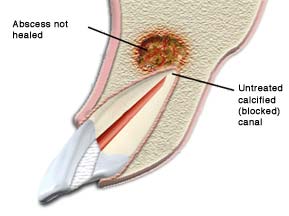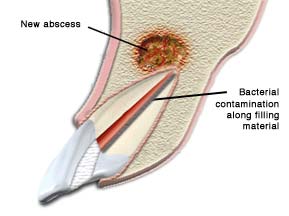Endodontic Retreatment
With proper care, most teeth that have had endodontic treatment can last as long as other natural teeth. In some cases, however, a tooth that has received endodontic treatment fails to heal or the pain continues. Occasionally, the tooth becomes painful or diseased months or even years after successful treatment. If your tooth has failed to heal or has developed new problems, you have a second chance. Another endodontic procedure may be able to save your tooth.

Improper healing may be caused by one or more of the following:
- Curved or narrow canals were not treated during the initial treatment.
- Complicated canals went undetected during the initial treatment.
- The crown or restoration was not placed within the appropriate amount of time following the procedure.
- The crown or restoration did not prevent saliva from contaminating the inside of the tooth.
In some cases, new problems can influence a tooth that was successfully treated, such as the following:
- New decay can expose a root canal filling material, causing infection.
- A cracked or loose filling or crown can expose the tooth to new infection.

Once retreatment has been selected as a solution to your problem, we will reopen your tooth to gain access to the root canal filling material. This restorative material will be removed to enable access to the root canal. The doctors will now clean your canals and carefully examine the inside of the problematic tooth. Once cleaned, the doctors will fill and seal the canals and place a temporary or permanent filling in the tooth. At this point, you will need to return to your dentist as soon as possible in order to have a new crown or restoration placed on the tooth to restore full functionality.
We will place a permanent or temporary filling, you may need a new crown or restoration if necessary
Ready for an Appointment?
Contact us Today!
SEO and Design services provided by Design Wizards . Privacy Policy.
The content of this website including but not limited to the images or any other marks are the property of their respective copyright owners and designers. All images and marks are used under license from their owners. Any copying or downloading without express written permission is a violation of copyright law and is prohibited.

